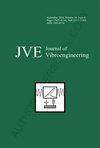Development of an empirical model for the prediction of the sound absorption coefficient for thin and low-density fibrous materials
IF 0.7
Q4 ENGINEERING, MECHANICAL
引用次数: 0
Abstract
Currently, FEA software such as ABAQUS uses empirical models to predict the sound absorption coefficient of poroelastic materials. However, based on a recent review of the literature it was found that the current sound absorption empirical models are inadequate for accurate prediction of thin (t < 20 mm), low-density materials (ρB < 50 kg/m3). Therefore, the predictions of the sound pressure levels in vehicle cabins, using such software, will be inaccurate since the trim materials are thin and have a low density. Thus, this research aimed to develop an empirical model that can accurately predict the sound absorption coefficient of these materials. Hence, polypropylene fibres consisting of four different diameters were manufactured and converted into nonwovens. Thereafter, airflow resistivity and impedance tube experimental testing were performed on the specimens. Subsequently, statistical analysis of the data was performed using SAS software. SAS was used to identify which independent variables should be included in the models to be developed. The empirical models were developed using the regression analysis toolbox in Microsoft Excel. Once the models were developed, various checks were performed to validate the assumptions of linear regression. The software NumXL was used to perform Cook’s distance tests. Thereafter, the models were validated against the validation dataset, where it was found that the developed exponential model performed best. Finally, the exponential model was compared to existing models using two data sets i.e. an internal dataset, and an external dataset derived from the literature. The developed model outperformed all the historic models on both datasets.开发用于预测薄型和低密度纤维材料吸声系数的经验模型
目前,ABAQUS 等有限元分析软件使用经验模型来预测孔弹性材料的吸声系数。然而,根据最近的文献综述发现,目前的吸声经验模型不足以准确预测薄(t < 20 毫米)、低密度材料(ρB < 50 千克/立方米)的吸声系数。因此,由于饰件材料较薄且密度较低,使用此类软件预测车厢内的声压级将是不准确的。因此,本研究旨在开发一种能够准确预测这些材料吸声系数的经验模型。因此,我们制造了四种不同直径的聚丙烯纤维,并将其转化为无纺布。随后,对试样进行了气流电阻率和阻抗管实验测试。随后,使用 SAS 软件对数据进行了统计分析。SAS 用于确定哪些自变量应包含在待建立的模型中。使用 Microsoft Excel 中的回归分析工具箱建立了经验模型。模型建立后,进行了各种检查以验证线性回归的假设。使用 NumXL 软件进行库克距离检验。之后,根据验证数据集对模型进行了验证,发现所开发的指数模型表现最佳。最后,利用两个数据集,即一个内部数据集和一个来自文献的外部数据集,将指数模型与现有模型进行了比较。在这两个数据集上,所开发的模型都优于所有历史模型。
本文章由计算机程序翻译,如有差异,请以英文原文为准。
求助全文
约1分钟内获得全文
求助全文
来源期刊

Journal of Vibroengineering
工程技术-工程:机械
CiteScore
1.70
自引率
0.00%
发文量
97
审稿时长
4.5 months
期刊介绍:
Journal of VIBROENGINEERING (JVE) ISSN 1392-8716 is a prestigious peer reviewed International Journal specializing in theoretical and practical aspects of Vibration Engineering. It is indexed in ESCI and other major databases. Published every 1.5 months (8 times yearly), the journal attracts attention from the International Engineering Community.
 求助内容:
求助内容: 应助结果提醒方式:
应助结果提醒方式:


